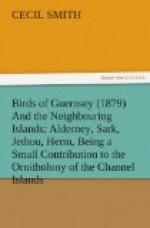5. Peregrine Falcon. Falco peregrinus, Tunstall. French, “Faucon pelerin.”—The Peregrine can now, I think, only be considered an autumnal visitant to the Islands, though, if not shot or otherwise destroyed, it would, no doubt, remain throughout the winter, and might perhaps have been resident, as Mr. MacCulloch sends me a note of one killed in Herm in December. All the Channel Island specimens I have seen have been young birds of the year, and generally killed in October or November. Adult birds, no doubt, occasionally occur, but they are comparatively rare, and it certainly does not breed anywhere in the Islands at present, though I see no reason why it should not have done so in former times, as there are many places well suited to it, and a constant supply of sea-birds for food. Mr. MacCulloch also seems to be of opinion that the Peregrine formerly bred in the Islands, as he says, speaking, however, of the Falconidae generally, “There must have been a time when some of the species were permanent residents, for the high pyramidal rock south of the little Island of Jethou bears the name of ‘La Fauconniere,’ evidently denoting that it must have been a favourite resort of these birds, and there are other rocks with the same name.” Certainly the rock here mentioned looks much like a place that would be selected by the Peregrine for breeding purposes, but that must have been before the days of excursion steamers once or twice a week to Jethou and Herm. Occasionally a young Peregrine is made to do duty as a Lanner, and is recorded in the local papers accordingly (see ‘Star’ for November 11th, 1876, copying, however, a Jersey paper), but in spite of these occasional notes there is no satisfactory reason for supposing that the true Lanner has ever occurred in either of the Islands. The birds, however, certainly resemble each other to a certain extent, but the young Lanner in which state it would be most likely to occur, may always be distinguished from the young Peregrine by its whiter head, and the adult has more brown on the head and neck.




